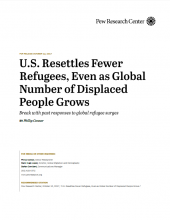U.S. Resettles Fewer Refugees, Even as Global Number of Displaced People Grows
This report presents a detailed demographic analysis of the incoming U.S. refugee population from FY 2002 to FY 2017 and includes the following data points: nationality, religious affiliation, gender, age, and state of resettlement. The author points out a number of trends observable in the data, including an increase in the share of refugees from the Middle East and Africa (from 17 percent in 2002 to 68 percent in 2017), the growth in the share of refugees who are Muslim, reaching 43 percent in FY 2017; and the large number of refugees ages 20 or younger (between 40 percent and 50 percent throughout this period). The author also tracks U.S. resettlement activity in the context of the worldwide refugee problem and notes that U.S. resettlement usually moves in tandem with the rise and fall of refugee numbers around the world. However, at a time when world refugee numbers have peaked at 17.2 million, the U.S. commitment to refugees has faltered in recent years, dropping to 0.2 percent of the world's refugee population, far less than the U.S. historic average of 0.6 percent. (American Immigrant Policy Portal)
Connor, P. (2017). U.S. Resettles Fewer Refugees, Even as Global Number of Displaced People Grows (p. 38). Washington, D.C.: Pew Research Center. Retrieved from http://www.pewglobal.org/2017/10/12/u-s-resettles-fewer-refugees-even-as...

